Image diagnoses for "Scalp (hairy)"
120 results with 343 images
Results forScalp (hairy)
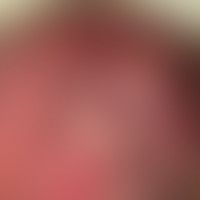
Melanosis neurocutanea Q03.8
Melanosis neurocutanea, detailed picture with multiple, sharply defined, pigmented, black spots and plaques.
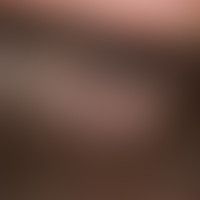
Lichen planus (overview) L43.-
Lichen planus of the capillitium: several atrophic plaques with discrete hair thinning.
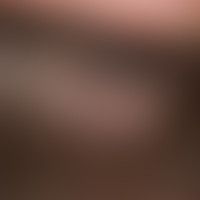
Lichen planus follicularis capillitii L66.1
Lichen planus follicularis capillitii: Increasing focal hair loss, reddish red with irregular, scarring alopecia (lack of follicular structure).

Lichen planus follicularis capillitii L66.1
Lichen planus follicularis capillitii. increasing spot-shaped hair loss with known Lichen planus. extensive redness with irregular, scarring alopecia (follicle structure is missing). itching.

Lichen planus follicularis capillitii L66.1
Lichen planus follicularis capillitii. increasing non-androgenetically caused hair loss. extensive redness with irregular, scarring alopecia (follicle structure is missing). itching and scaling
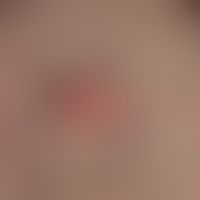
Nevus sebaceus Q82.5
Naevus sebaceus: congenital, initially unnoticed, bumped, red hairless area; for several months formation of a painless, repeatedly bleeding node (arrow mark) Dg.: Naevus sebaceus with formation of a solid basal cell carcinoma.

Nevus sebaceus Q82.5
Naevus sebaceus: chronically inpatient, solitary, approx. 4.0 x 2.0 cm, sharply defined, oily shiny, sour, orange-coloured, consistency increased, flatly elevated, symptomless plaque on the capillitium of a 35 years old patient, existing since birth. Within the skin change, at the lower right edge, a solitary bright round papule is visible.
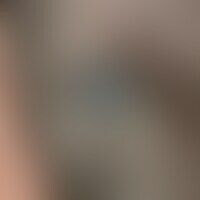
Blue nevus D22.-
blue nevus. blue-black, coarse, sharply defined, calotte-shaped node with a smooth, like polished, shiny surface. in addition, hairs run through the node. follicle ostia funnel-like indented. especially the detection of hairs in the node area speaks against malignancy (DD: nodular malignant melanoma), because the tumor growth does not infiltrate and destroy the hair follicles.

Atopic dermatitis in infancy L20.8
Superinfected atopic dermatitis:chronic pyodermic eczema in an infant
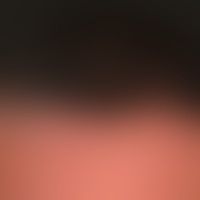
Psoriasis capitis L40.8
Psoriasis capitis: diffuse reddening of the entire capillitium with coarse lamellar scaling. Here in a 42-year-old patient with extensive psoriasis of the entire integument. Typically, the changes exceed the forehead-hairline.

Psoriasis capitis L40.8
Psoriasis capitis: chronic, solitary, for months, localized on the forehead and in the hairy area, sharply defined (arrows), symptomless, red, rough plaque with coarse surface scaling.
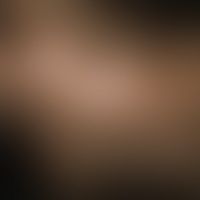
Microsphere B35.0
Microspore (Tina capitis caused by Microsporun canis) : Scaling and breaking off hair in the parting area in a 6-year-old girl. no itching. fungal culture: masses of Microsporum canis.

Alopecia (overview) L65.9
Trichotillomania; for 2 years in a 9-year-old boy a circumscribed, flat alopecia of varying extent; due to incomplete and frequent pulling out of the hairs single tufts of hairs have stopped again and again.

Alopecia (overview) L65.9
Alopecia, scarring alopecia in a 13-year-old female patient with known lupus erythematosus without systemic involvement.
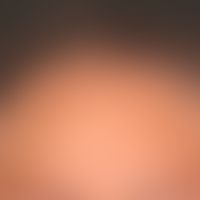
Alopecia (overview) L65.9
Alopecia postmenopausal, frontal, fibrosing: uniform receding of the frontal and temporal hairline. moderately pronounced ulerythema ophryogenes. keratosis follicularis on the extensor extremities.
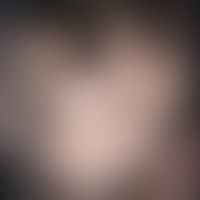
Alopecia (overview) L65.9
Alopecia areata. roundish, centrifugally and medially spreading, smooth, hairless area with preserved follicles. in the active marginal area hair can be pulled out in bundles. under internal steroid treatment with methylprednisolone for 4 weeks, hair re-growth occurred in places.

Alopecia (overview) L65.9
Alopecia androgenetica in the female. classic, initial androgenetic alopecia of the female pattern, with preserved frontal hair and emphasis on the high-parietal hair areas in a 16-year-old female patient. secondary findings are generalized hypertrichosis since childhood. the patient's sister is also affected, previous generations are all free of symptoms.

Alopecia (overview) L65.9
Alopecia, androgenetic: typical infestation pattern in androgenetic alopecia.

Alopecia (overview) L65.9
Pseudopélade: Irregularly limited, hairless area. follicular structure is completely absent in the hairless area. thus a "scarred" final state of a previously expired inflammation leading to scarring is present. in congenital hairlessness the healing state of an "aplasia cutis congenita circumscripta" is present (see there).
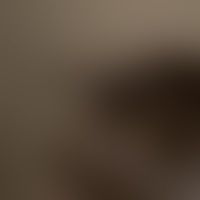
Trichorrhexis nodosa L67.0
Trichorrhexis nodosa. broken, difficult to comb, stubborn hair. conspicuous abrupt kinking of the hair shaft.

Lupus erythematodes chronicus discoides L93.0
Lupus erythematodes chronicus discoides: older, not (no longer) active, "discoid" lupus focus, healed under atrophy of skin and subcutis (complete destruction of the hair follicles, surface parchment-like smooth - see inlet).

Lupus erythematodes chronicus discoides L93.0
lupus erythematodes chronicus discoides. alopecia existing for 4 years. multiple, smaller and larger alopecic foci, with centrifugal expansion. in the center larger hairless, scarred area (no evidence of follicular structures). the patient complains of a temporary hyperesthesia of the affected areas. encircles a still active zone of CDLE.

Superficial tinea capitis B35.0
Tinea capitis superficialis: non-inflammatory, blurred, alopecic foci in the parting area in a 6-year-old girl. fine whitish scales and breaking off hairs. no itching. fungal culture: masses of Microsporum canis.

Pediculosis (overview) B85.2
Pediculosis (overview): masses of nits on the hair shafts in pediculosis capitis.
